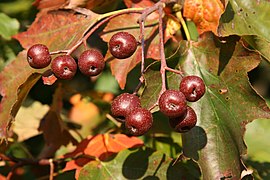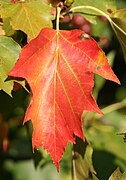Torminalis
| Torminalis glaberrima | |
|---|---|

| |
| Scientific classification | |
| Kingdom: | Plantae |
| Clade: | Tracheophytes |
| Clade: | Angiosperms |
| Clade: | Eudicots |
| Clade: | Rosids |
| Order: | Rosales |
| Family: | Rosaceae |
| Genus: | Torminalis Medik. |
| Species: | T. glaberrima
|
| Binomial name | |
| Torminalis glaberrima (Gand.) Sennikov & Kurtto
| |
| Synonyms[2] | |
|
List (Genus)
(Species)
| |
Torminalis is a genus of plants in the rose family, Rosaceae.[2] The genus was formerly included within the genus Sorbus as the section Torminaria, but the simple-leafed species traditionally classified in Sorbus are now considered to form a separate monophyletic group.[3] It is monotypic, being represented by the single species Torminalis glaberrima, commonly known as wild service tree, chequers, and checker tree.[4] This tree is native to Europe, parts of northern Africa and western Asia.
A possible second species in the genus has been identified through DNA analysis, but a new scientific description for it has not yet been written.[5]
Description
[edit]Torminalis glaberrima is a medium-sized deciduous tree growing to about 30 m (100 ft) tall, with a trunk up to 1.3 m in diameter. The bark is smooth and grey when young, becoming scaly and flaking away in squarish plates to reveal darker brown layers when about 30 years old. Young twigs are lightly hairy, quickly becoming glabrous, and brownish in colour. Winter identification is made easier by the buds, which are green and pea-sized with obvious brown-edged scales.[6][7]
The leaves are 6–14 centimetres (2–6 inches) long and broad with a 2.5–5 cm (1–2 in) petiole, dark green on both sides, with five to nine acute lobes; the basal pair of lobes are spreading, the rest more forward-pointing and decreasing in size to the leaf apex, and with finely toothed margins; the undersides have small hairs when young, but both sides are smooth and shiny when older; the autumn colour is yellow to red-brown. The flowers are 10–15 millimetres (3⁄8–5⁄8 in) in diameter, with five white petals and 20 creamy-white stamens; they are produced in corymbs 5–12 cm (2–4+1⁄2 in) diameter in late spring to early summer, and are hermaphroditic and insect pollinated. The fruit is a globose to ovoid pome 10–15 mm in diameter, greenish to russet or brown, patterned with small pale lenticel spots when mature in mid to late autumn.[8][9][10]
Taxonomy
[edit]Wild Service-tree was first named by Linnaeus as Crataegus torminalis in 1753, but of course it was known long before that. Pre-Linnean polynomials include Crataegus foliis cordatis acutis: lacinulis acutis serratis, "the hawthorn with sharp cordate leaves [and] sharp serrated lobes", from Hortus Cliffortianus, 1737, and Mespilus, apii folio, sylvestris non spinosa "the spineless mespil of the woods, with celery leaves", from Bauhin's Pinax Theatri Botanici, 1623. In fact, the name written in the margin of Species Plantarum is Crataegus terminalis, but the "e" may have been a misprint, as "torminalis" was already well-established.[11]
Which genus the wild service-tree should be placed in has been a matter of debate for centuries. Apart from Linnaeus's original Crataegus, it has been placed in Pyrus, Malus, Mespilus, Torminaria and various other genera over the years.[12] Until recently it was commonly known as Sorbus torminalis but since about 2010 it has become increasingly apparent from genetic studies that it is not very closely related to the pinnate-leaved plants in that genus.[13] The currently accepted name was published in 2017[14] and is endorsed by more recent studies. However, there is still some uncertainty about whether it should be in a genus on its own or combined with some other closely-related plants.[15]
- Torminalis glaberrima var. torminalis. Europe, northwest Africa.
- Torminalis glaberrima var. caucasica. Caucasus and Alborz Mountains. Leaves less deeply lobed than in var. torminalis.
Torminalis glaberrima is a sexually reproducing diploid species that forms diploid and polyploid hybrids with members of the genus Aria (whitebeams).[16] A number of often very localised stable apomictic polyploid species of ultimately hybrid origin between Sorbus torminalis and various species in the genus Aria occur in Europe, including Sorbus latifolia (service tree of Fontainebleau), and S. bristoliensis (Bristol whitebeam).[8] They are now classified as the Karpatiosorbus genus.
Etymology
[edit]The tree's Latin name, torminalis, means "good for colic".
The name "service-tree" is thought to be derived from the Latin word for beer, cervesa. This in turn is an adaptation of the (hypothetical) Proto-Celtic term *kurmi, and was introduced into the Roman language by Pliny the Elder in his Natural History of 77 AD. Thus, the words "sorb", "Sorbus", and "serve/service" all come ultimately from the Celtic word for beer, and are applied to this plant because the fruits of the closely-related true service tree were used to flavour that beverage in ancient Gaul.[17][18]
In Anglo-Saxon, *kurmi became syrfe, either by re-importation from Vulgar Latin[19] or directly from the Celtic, and has since morphed into a variety of forms, including "Surrey".[20] Another English common name is "chequers (or checkers) tree", for which a variety of origins have been proposed. Some authors have suggested that the pattern of dots on the fruits,[21] or the appearance of the bark, is similar to that of a checkers board or a pub sign;[20][22] but it could simply be that "chequers" and "chokers" are more evolutions of the original cervesa.
Distribution and habitat
[edit]It is found from Great Britain (England and Wales) east to Denmark and Poland, south to northwest Africa, and southeast to southwest Asia from Asia Minor to the Caucasus and Alborz mountains.[8]
The wild service tree favours deep fertile soils, but can tolerate a wide range of soil conditions, from chalky, superficial, dry soils to temporarily waterlogged soils, often found alongside the true service tree. It can adapt to a variety of climatic conditions, but occurs most often in lowlands. Wild service tree is a light-demanding species, often out-competed by other hardwood species.[23]
It is relatively rare and in Britain is now usually confined to pockets of ancient woodland, although it can also be found growing in hedgerows. It can often be found associated with oak and ash woods. In Britain, summer temperatures are often too low for the seeds to ripen, so its principal method of propagation is by suckers.[8] Its Ellenberg values in Britain are L=4, F=5, R=6, N=5 and S=0, which means it grows in shady, moist woodland on neutral soils and with moderate fertility, and no tolerance for salt.[24]
Ecology
[edit]The fruits are eaten by many birds and a few mammals, making the tree ecologically important.[23]
Uses
[edit]
The wild service tree is one of the most valuable hardwoods in Europe. The wood is fine-grained, very dense and has good bending strength. It was used in the past to make screws for winepresses, billiard cue sticks, musical instruments and turnery. Today, it is usually only used for decorative veneers.[23]
The fruit, sometimes called "chequers", are edible and taste similar to dates, although they are now rarely collected for food. They are usually too astringent to eat until they are over-ripe and bletted. They were traditionally known as a herbal remedy for colic. Before the introduction of hops, the fruit were used to flavour beer.[22]
Gallery
[edit]-
Trunk and leaf canopy
-
Leaves
-
Flowers
-
Foliage and fruit
-
Ripe fruit
-
Autumn leaf colour
References
[edit]- ^ Rivers, M.C. & Beech, E. (2017). "Sorbus torminalis". IUCN Red List of Threatened Species. 2017: e.T61957590A112312183. doi:10.2305/IUCN.UK.2017-3.RLTS.T61957590A112312183.en. Retrieved May 31, 2024.
{{cite journal}}: CS1 maint: multiple names: authors list (link) - ^ a b "Torminalis glaberrima (Gand.) Sennikov & Kurtto | Plants of the World Online | Kew Science". Plants of the World Online. Retrieved September 12, 2023.
- ^ Lo, E.Y.Y.; Donoghue, M.J. (2012), "Expanded phylogenetic and dating analyses of the apples and their relatives (Pyreae, Rosaceae)", Molecular Phylogenetics and Evolution, 63 (2): 230–243, Bibcode:2012MolPE..63..230L, doi:10.1016/j.ympev.2011.10.005, PMID 22293154
- ^ "Taxon: Sorbus torminalis (L.) Crantz", USDA GRIN Taxonomy, archived from the original on September 18, 2016, retrieved June 30, 2016
- ^
- "Specimen Record GBITS49382-21 (ITS1, 5.8S, ITS2) | Public Data Portal | BOLDSYSTEMS". www.boldsystems.org. Retrieved September 20, 2023.
- "Generic limits of Pyrinae: Insights from nuclear ribosomal DNA sequences". Botanical Studies. 53 (1): 151–164. 2012.
- ^ Thomas, P. (2017). "Biological Flora of the British Isles: Sorbus torminalis". Journal of Ecology. 105 (6): 1806–1831. doi:10.1111/1365-2745.12857. JSTOR 45029467 – via JSTOR.
- ^ Price, D.; Bersweden, L. (n.d.). Winter Trees: a photographic guide to common trees and shrubs. Field Studies Council. ISBN 978-1-9088-19-11-6.
{{cite book}}: CS1 maint: year (link) - ^ a b c d e Rushforth, K. (1999). Trees of Britain and Europe. Collins ISBN 0-00-220013-9.
- ^ Mitchell, A. F. (1974). A Field Guide to the Trees of Britain and Northern Europe. Collins ISBN 0-00-212035-6
- ^ Blamey, M. & Grey-Wilson, C. (1989). Flora of Britain and Northern Europe. ISBN 0-340-40170-2
- ^ Linné, Carl von; Linné, Carl von (1753). Species plantarum : exhibentes plantas rite cognitas ad genera relatas, cum diferentiis specificis, nominibus trivialibus, synonymis selectis, locis natalibus, secundum systema sexuale digestas. Vol. t.1 (1753). Berlin: Junk.
- ^ "Torminalis glaberrima (Gand.) Sennikov & Kurtto". www.gbif.org. Retrieved February 9, 2025.
- ^ Lo, Eugenia Y. Y.; Donoghue, Michael J. (May 1, 2012). "Expanded phylogenetic and dating analyses of the apples and their relatives (Pyreae, Rosaceae)". Molecular Phylogenetics and Evolution. 63 (2): 230–243. doi:10.1016/j.ympev.2011.10.005. ISSN 1055-7903. PMID 22293154.
- ^ Sennikov, Alexander N.; Kurtto, Arto (June 13, 2017). "A phylogenetic checklist of Sorbus s.l. (Rosaceae) in Europe". Memoranda Societatis Pro Fauna et Flora Fennica. 93: 1–78. ISSN 1796-9816.
- ^ Ulaszewski, Bartosz; Jankowska-Wróblewska, Sandra; Świło, Katarzyna; Burczyk, Jarosław (2021). "Phylogeny of Maleae (Rosaceae) Based on Complete Chloroplast Genomes Supports the Distinction of Aria, Chamaemespilus and Torminalis as Separate Genera, Different from Sorbus sp". Plants. 10 (11): 2534. doi:10.3390/plants10112534. ISSN 2223-7747. PMC 8618278. PMID 34834899.
- ^ Pellicer, J.; Clermont, S.; Houston, L.; Rich, T.C.; Fay, M.F. (2012). "Cytotype diversity in the Sorbus complex (Rosaceae) in Britain: sorting out the puzzle". Annals of Botany. 110 (6): 1185–1193. doi:10.1093/aob/mcs185. PMC 3478048. PMID 22922587.
- ^ Brown, Lesley (1993). The New Shorter Oxford English Dictionary on Historical Principles, vol. 2 (4th ed.). Oxford University Press. ISBN 0-19-861271-0.
- ^ "Words for beer - Zythophile". zythophile.co.uk. December 30, 2009. Retrieved February 7, 2025.
- ^ "service", Wiktionary, the free dictionary, January 19, 2025, retrieved February 7, 2025
- ^ a b Mabey, Richard (1996). Flora Britannica. London: Reed International. ISBN 1-85619-377-2.
- ^ Oxford English Dictionary
- ^ a b G. J. Monson-Fitzjohn gives three possible origins for chequers as a pub name: the chequer board suggests the passing away of odd hours by a game of "draughts"; others were named from the custom of painting signposts sometimes found outside pubs in alternate black and white squares; and others from the "chequy field" of the coat of arms of a local landowner. 270 hotels, tavern and inns then bore the name.--Monson-Fitzjohn, G. J. (1926) Quaint Signs of Olde Inns. London: Herbert Jenkins (reissued by Senate, London, 1994 ISBN 1-85958-028-9); pp. 34, 45
- ^ a b c Demesure-Muschm, B. & Oddou-Muratorio, S. (2004), Wild service tree - Sorbus torminalis: Technical guidelines for genetic conservation and use (PDF), European Forest Genetic Resources Programme, p. 6, archived from the original (PDF) on January 31, 2017
- ^ Hill, M.O.; Preston, C.D.; Roy, D.B. "PLANTATT - Attributes of British and Irish Plants - Spreadsheet". UK Biological Records Centre.
Further reading
[edit]- Wedig Kausch-Blecken von Schmeling: Die Elsbeere. Bovenden 1994, ISBN 3-88452-925-0
- Roper, P. (1993). "The distribution of the Wild Service Tree Sorbus torminalis (L.) Crantz, in the British Isles" (PDF). Watsonia. 19: 209–229. Archived (PDF) from the original on December 23, 2022.
External links
[edit]- Wild Service Tree at rhs.org.uk
- Sorbus torminalis - distribution map, genetic conservation units and related resources. European Forest Genetic Resources Programme (EUFORGEN)







